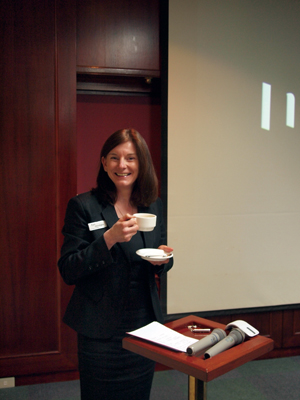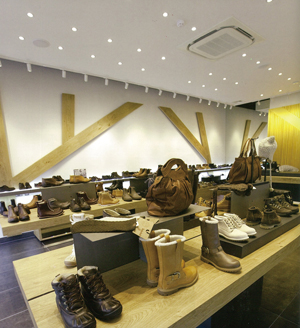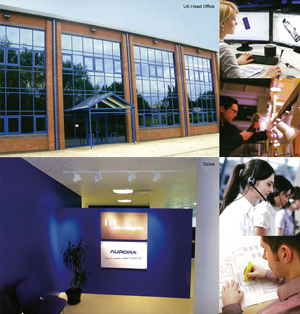Microlights Brings Retail Lighting Expertise to Taiwan
Store lighting supplier offers efficient solutions to retailers everywhere
2013/01/07 | By Ken LiuAmanda Radley, International Sales Director of Microlights Ltd., a member of the Aurora Group of the United Kingdom, made her first-ever trade presentations in Taiwan (one each in Taipei and Taichung) in May 2012. Her objective was to make the company’s Taiwanese teams more familiar Aurora’s lighting expertise, so that they would be better able to offer it to the local market.
“China, Taiwan, and other Asian countries are key growth areas for the retail sector – global brands are increasingly focused on this area,” she said during an interview with CENS Lighting. “Our goal is to create regional expertise able to bring the Microlights offer to retail brands.”

Founded in 1984, Microlights is the world’s No. 1 supplier of tailored retail lighting solutions. It has completed thousands of lighting projects for the stores of clients in over 80 countries, including Starbucks, GAP, Calvin Klein, Tesco, Marks & Spencer, F&F, Timberland, Victoria’s Secret, and American Eagle.
The Aurora Group, reportedly the U.K.’s No.1 lighting wholesaler, acquired Microlights in 2009, and the company now accounts for around 30% of the group’s sales revenue. According to Radley, Microlights achieved a 22% revenue growth in 2011 and will maintain that growth rate in the coming years. “Our goal is to continue growing,” she stressed.
The company is working toward that goal by providing local support for clients that are going international. It began the process of business globalization around 2000 by setting up offices in Dubai and France.
A true paradigm shift came to the company in 2004, when it decided to change its business structure in order to better support the growth of retailers. “We really re-examined our business to see what growth potential would be in the future,” Radley commented. “And that came together with the original shareholders from Microlights retiring and a new management team coming into the business in 2004, which eventually ended up with the sale of Microlights to Aurora. So, really it was a milestone within the structure of Microlights—new thinking, new people, and a new team of people running the business that led the step change in strategy.”

This change came at a time when brand retailers were increasingly globalizing their operations. Radley’s company started out by supporting the retail brands it already worked with in Britain as they expanded into overseas markets. “So we created offices in different countries to support the brands locally,” she added. The company opened an office in Spain in 2005 and another in Lebanon in 2008.
Going International
Since 2004, the company has gone from a 77% reliance on the British market to exporting 77% of its manufactured items. “So, clearly this is a successful strategy for our business, and it is the one we are looking forward to building on,” Radley said.
In examining the way retailers are moving into overseas markets, Radley has found that Brazil, India, Russia, and China (the BRIC economies) are the four market areas that retailers in general consider to be the big growth areas for their business. “So, we clearly see retail growth in the BRIC markets,” she noted. Her company has signed up a partner each in India and Russia, and is researching the market in Brazil.

In the Greater China region, Microlights already has retailers and suppliers in mainland China, has just introduced its expertise to Taiwan, and has chosen Hong Kong as the next stop after Taiwan for its Asian presentation tour. “This time we come to Taiwan to demonstrate to our team here our product range and the way Microlights goes to market and communicates with clients--what the unique features of our products are and how we sell them,” Radley explained.
Microlights can take advantage of Aurora’s strong manufacturing, R&D, outsourcing, and marketing capabilities in Taiwan and mainland China to offer unique solutions for international retailers that are in Asia or are moving into the region, as well as to homegrown retailers in the Taiwanese and Chinese markets. “With our link [to Aurora],” the sales director said, “we clearly have a very good footprint in the Asian market.”
In mainland China, Aurora operates a product inspection and sourcing site in Ningbo, a dimmer R&D and manufacturing site in Xiamen, and a manufacturing, consolidation, R&D, painting, and sales and marketing site in Guangdong. In Taiwan, it has an R&D and sales facility.
Microlights uses its bases in Taiwan and mainland China, backed up by its strong engineering team in the mainland, to introduce new products which it designs and develops in Europe. “So we have big synergies within the group,” Radley said. “Also, we are exchanging both product knowledge and expertise on how to get those products into market in the right way.”
The 2009 acquisition gave Aurora and Microlights a chance to integrate their expertise. “We regard it as skill integration,” Radley explained. “In China and Taiwan, Aurora has big strength in manufacturing and in LED engineering process and R&D. In the U.K, where we’ve been a manufacturer since 1984, we have great strength in not just luminaires and lighting technology for retailers, but also [in meeting the] requirements of retailers who are unique client types. Integration allows us to strengthen manufacturing in the Taiwanese and Chinese market for the Aurora product ranges.”
Under the Aurora umbrella, the two entities concentrate on different market segments, each using its own brand name. “The group’s decision is that Aurora is a global name for the distribution market, where it has considerable strength, whereas Microlights is a brand name promoted globally for the project business, which encompasses the retail sector which we are in now,” Radley noted. “For the last 20 years, Microlights has specialized in manufacturing luminiaries in order to light shops,” she added.
Lighting the Way to Profit
Microlights boasts many advantages in the market, including tailored solutions, unique reflector technology, flexible designs, local services, and complete manufacturing capability. Most of these advantages are built on the company’s specialization in a multitude of particular sectors, which allows it to develop reflector technology that is appropriate to light retailing--a really unique style of supporting retailers, flexible manufacturing, complete support service, and expertise in discussing with retailers. “We understand exactly how to design retailers’ stores, and we have expertise in serving the stores as they grow globally,” Radley stressed. “One of our core strengths is the ability to design specifications which are suitable for stores in the home market but can also expand and support clients going worldwide.”
Also, Radley asserted, “There are not many luminaire manufacturers in the world that have the ability to deliver in the East and West.”
Part of the company’s service to brand retailers is to review the light source technologies which are available on the market and make for them the selections which the company feels are most appropriate. “We always bring to our clients the very latest light sources that fit the right technology for the market we serve,” Radley said.
Ceramic metal halide lighting is among the right technologies that the company chooses for its clients, because, Radley emphasized, these lights offer good lamp life and good efficiency in addition to good color rendition. “Within a retail store,” she explained, “we look to create a certain ambience and differentiation that is going to increase shopper footfall within the store and that is going to direct shoppers around the store so that they stay inside as long as possible and spend as much money as possible. So, we are choosing light sources that are the best ones to do that. We wouldn’t choose to use low-pressure sodium lighting, because its color rendition is not good enough to really show merchandise at its best.”
Radley said that her company is very excited about the development of LEDs, as it permits new things for the market such as the ability to offer color changing, which conventional technologies can’t do. “We’ve been watching and monitoring the evolution in LED technology,” she noted, “because we see this very much the next step and next revolution in lighting source.”
She emphasized, however, that the LED product range must be introduced in the right way. “We don’t introduce 3,000 Kelvin luminaire, which is sometimes a little bit blue and sometimes a little bit pink, because that is not the right solution for retailers,” she said. “Also, we need to use the right power output, or lumen package-power ratio, if you like; so in order to get sufficient lumens to create the right ambience in stores, we want to have the right LEDs that can deliver that. But we need to be able to control it as well. So, we need to develop reflector technology which controls the LED in a way which makes it usable in stores.”
Specializing in retail lighting, Radley feels, allows the company to focus its product development on reflector technology and how to use the technology in the most efficient way for retailers. “If you consider general lighting,” she explained, “most luminaire manufacturers creating luminaires for offices, hotels, and meeting rooms are looking to create a luminaire which does not produce glare on computer screens and is tightly controlled in output. That’s fine for general uses, but Microlights takes the view that in retail most merchandise is displayed in a vertical plane. So by creating reflectors that direct light on the vertical plane, we would not waste light on the horizontal surfaces.”
To that end, the company designs its ambient reflectors to direct light on merchandise, so that it can deliver the right lux level using much fewer luminaires. “Overall,” Radley noted, “if you use fewer luminaires, the capital cost, the installation cost, and the energy cost all go down. But the right lux level is still delivered.”
Targeted Lighting
At the heart of the company’s reflectors is what it calls “hotspot technology.” “In order to create differentiation within a store,” Radley explained, “we need a lighting level on the target objects--the mannequins, for instance--and other fascination points, which is three to five times brighter than the ambient level, so the eyes of shoppers can make out that difference and follow their feet, or the feet follow the eyes. This is the way you make shoppers visit the whole store and, hopefully, spend the money. In order to do that, we use what we call ‘hotspot technology’ to create an area of intense light in the center of our object, and a halo effect around the intense point so that differentiation on the objects or mannequins is created.”
All of the company’s solutions, including the reflector technology, are provided by a strong team of designers—20 to 30 of them worldwide. “They’ve been with this company for a very long time and reflector technology is the core of what we do,” Radley stressed. “Anything they do has to deliver excellent lighting and the most cost and energy efficient solutions in terms of light delivery in a store.”
The team, Radley added, develops solutions that are easy and quick to install and easy to maintain. And, she added, “Their solutions must offer good lamp life and quality. Because what we try to do is make through-life cost to retailers as good as possible. It’s not just about the initial capital; it is about how you amortize the cost of that capital and cost associated with it throughout the life of the store. That’s something Microlights has been doing for many years.”
Radley stressed that while the company is the world’s No. 1 reflector supplier of retail applications, it supplies retailers more than just products, reflector technology, or energy saving. “It is also about the expertise of our skilled people and commercial managers in really understanding the needs of the retailers and their business,” she noted. “And the whole logistic and supply chain is absolutely what makes it possible for us to deliver perfect lighting solutions to retailers on time. For instance, shop lighting is very fast-moving. If a commercial center has some space available, the retailer will want to take that space very quickly. And the more quickly he can install his shop and start trading, the sooner he can make money. The faster Microlights can respond to that demand, the better we can support our retail customers. Unfortunately, many businesses don’t have the flexibility or supply chain set up in the right way to support the needs of retailers. So, clearly the strength of our brand and business is built not only around very good luminaire and reflector technologies, but also our efficient service.”
The company’s global supply capability is partly built on the broad range of approvals and standards that it has acquired, including a difficult approval, essential for success in the Middle Eastern market, from Saudi Arabia. “The fact that we have standards and approvals necessary to enter global markets means the retailer can select one luminaire manufacturer that he can use for shops everywhere. And that way he is confident that his brand everywhere looks exactly the same,” Radley said.
Most Light with Least Energy
Microlights’ designs highlight energy saving, something that the company has been doing for the past 20 years, according to Radley: “Everything we do is about offering energy efficiency and low through-life costs. But that’s not just about the light source. It’s rather about how you use the light source with a reflector or how you develop an optic to get the maximum output from a light source in the right direction. So, I think we need to consider both the light source and the control of the light source as a package and how it delivers energy saving, rather than considering LED in isolation.”
She claimed that the reflectors that the company creates for the market provide excellent efficacy, which means the company is lighting a store in a very high energy-saving way.
Radley expressed the belief that LEDs, with their low wattage, can replace 50W halogen lamps and provide a very good lighting solution. Initially, she thinks, LEDs will enjoy great success in the domestic sector, because many homes in Europe use 50W halogen lamps, which produce light of a very good quality. “But they are very inefficient in terms of the way they convert power into light,” she noted.
She cautioned, however, that LED is not the only energy-saving solution. “There’s been a lot of publicity about the fact that LED is the energy-saving solution,” she commented. “I think the risk with new technology is that people rush to try things out before they really establish what is good and what is bad.”
Radley reported that in the U.K., Microlights has been working with the government-sponsored ECA (Enhanced Capital Allowance) Scheme for about 10 years, and that the majority of its fittings conform to the requirements of the scheme’s tax incentives. ECA offers tax advantages for companies that implement energy-efficient technologies, whether in lighting, refrigeration, or air-conditioning equipment.
Radley concedes that globalizing a business is not without challenges. “Clearly,” she said, “there are challenges in opening any new market because, I think, each market has unique aspects. So when you are entering into a new market, you need to modify around the edges of the knowledge you have to fit the culture of the territory you’re moving into. For instance, we have been operating in the Middle East now for 10 years; and, through the process of tailoring, the skill that Microlights originally possessed was made suitable for the Middle East market.”
The confidence of the Microlights sales director in the company’s global prospects is based, to no small extent, on good relations with clients. “If you can create a good trusting relationship with clients, the clients will recommend you to other clients. This is the best way for us to grow,” Radley concluded.

